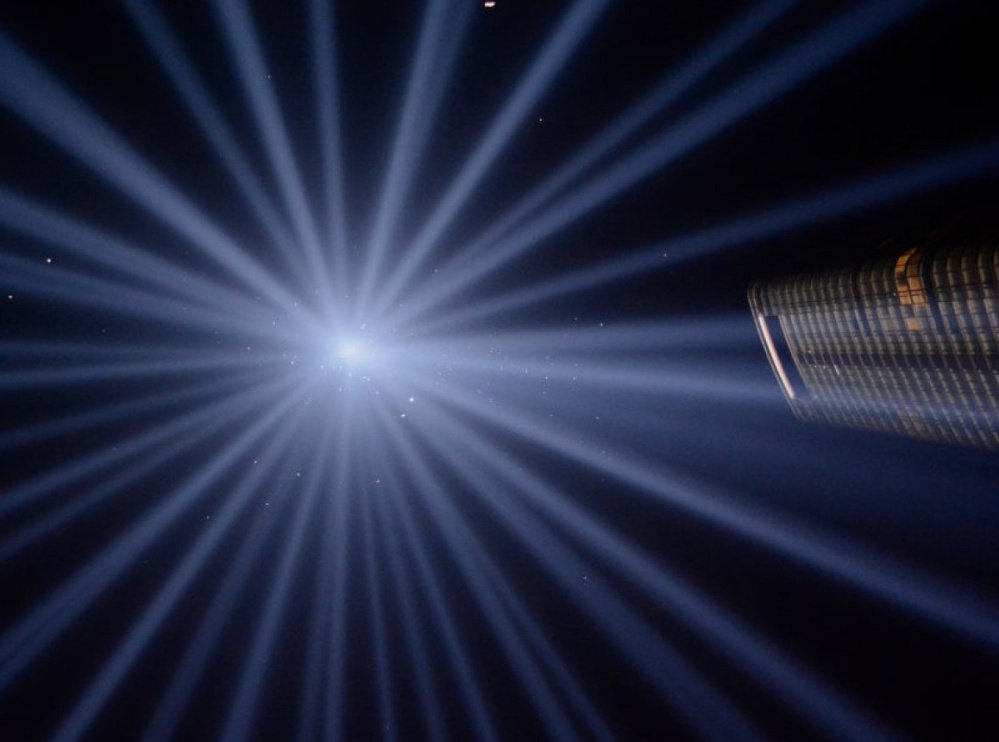Most years, sundown on Sept. 11 finds Susan Elbin standing atop a parking garage in Lower Manhattan. She watches as technicians turn on dozens of 7,000-watt bulbs to create two brilliant columns of light – an ethereal tribute to the towers that fell there and the people who lost their lives inside them.
Darkness falls, and there’s suddenly movement inside one of the beams, something that dips, whirls and calls out in high-pitched chirps. Then more shapes appear. They’re birds, circling endlessly inside the columns as though caught in a trance. Elbin and her colleagues count tens of thousands of them over the course of the night.
“You can see the pillars of light sort of filling up with birds, almost like they’re pouring in from the top,” recalled Elbin, director of conservation and science at New York City Audubon. “It’s just this combination of awe and thinking, ‘Gosh, we have to do something to get these birds back on their way.’”
In a paper published Monday in the Proceedings of the National Academy of Sciences, Elbin and her colleagues report the results of their yearly tally: Between 2008 and 2016, roughly 1.1 million migrating birds were affected by the “Tribute in Light” annual installation.
For some, the attraction was fatal: Unable to escape the thrall of the beams, the birds became disoriented and exhausted by hours of mindless spiraling flight. Some simply fell to the ground; others were more likely to strike buildings when the sun rose and they could finally fly away.
The research at the 9/11 tribute illuminates the growing hazard posed by artificial light, Elbin says. Accustomed to traveling under the cover of darkness, migratory birds become disoriented by the glow from cell towers, floodlights, stadiums, office windows and streetlamps. Scientists can still only guess at the cumulative impact of all this light pollution on bird populations, but with numbers of most migratory bird species in decline, it probably isn’t good.
Yet working with the artists behind the memorial, Elbin and her colleagues found a way to free the birds from the light column spell. Their success could guide other efforts to protect creatures that fly by night.
The Tribute in Light first illuminated the skies above New York in spring 2002 and is re-lit each year on the anniversary of the Sept. 11, 2001 attacks. It consists of 88 bulbs arranged in two large squares to create 4-mile-high light pillars that can be seen from 60 miles away.
To Elbin, who was working just across the Hudson River when the twin towers were struck 16 years ago, the sight of the beacons was deeply moving. But it also worried her. The anniversary of the attacks coincides with most birds’ annual migration south.
“Lower Manhattan is … a risky place for birds anyhow,” Elbin said. She and her colleagues often find feathered carcasses of those that flew into the reflective glass windows of the neighborhood skyscrapers. Add the disorienting effect of a powerful artificial light, and, Elbin said, “we predicted there would be a problem.”
In 2005, NYC Audubon scientists and volunteers got permission to count the birds caught in the columns from the rooftop, where the bulbs are arrayed. They were joined by researchers from the Cornell Lab of Ornithology, who could identify the species involved and used radar to understand how far the beacons’ lure extended. Radar imagery of bird density over the tri-state area on Sept. 11 and 12, 2015 shows a bright red hot spot over the lower part of Manhattan.
According to Kyle Horton, a Cornell ornithologist who was lead author on the paper, scientists don’t know why birds are so mesmerized by light. Research suggests that it may interfere with their ability to detect subtle visual cues, such as starlight, that they use to find their migration routes. Some birds fly to the beams to hunt insects, like moths, that also are drawn to the glow.
Whatever its cause, the behavior is troubling. In recent years, scientists have seen migration paths shift toward light-polluted cityscapes, which harbor countless other hazards for traveling birds – windows, cats, food made toxic by pesticides. Even if the birds avoid death, the disorientation caused by human lights forces them to waste precious time and energy they need for their marathon journeys south.
“We don’t know how successful these migrants may be on the rest of their journey,” Horton said. But the distraction “certainly has some cost.”
This is a solvable problem. In recent years, scientists have let the memorial’s operators know when too many birds are present in the beams. If the count exceeds 1,000 or if census-takers see a creature fall from exhaustion, the lights are turned off one by one until the birds disperse. According to NYC Audubon, survivors of the terrorism attack said the last thing they wanted was for the memorial to be a site of still more death.
Send questions/comments to the editors.



Success. Please wait for the page to reload. If the page does not reload within 5 seconds, please refresh the page.
Enter your email and password to access comments.
Hi, to comment on stories you must . This profile is in addition to your subscription and website login.
Already have a commenting profile? .
Invalid username/password.
Please check your email to confirm and complete your registration.
Only subscribers are eligible to post comments. Please subscribe or login first for digital access. Here’s why.
Use the form below to reset your password. When you've submitted your account email, we will send an email with a reset code.